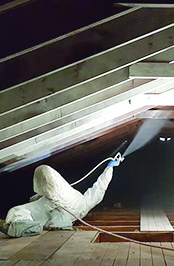
Courtesy Bio Armor
By Jennifer Farnsworth
One thing homeowners don’t want to hear is, “you have mold.”
Area professionals can provide help with a series of steps to remove mold from a home.
“The most important thing for a homeowner or business owner to first understand is that there are steps to mold remediation,” said Mario Gonzalez, of Bio Armor in Ballston Spa.
He said before the mold can be removed, a “mold assessor” has to first meet with the homeowner to determine if there is mold and how it can be removed.
“The most important things to know is that once you find it, you have to determine the reason, fix it, remove the mold and cleanup and then monitor it,” said Bob Serafini of Quick Response Restoration in Round Lake. “Have proper ventilation, use dehumidifiers if necessary and work with a trusted professional.”
Serafini said many times people don’t realize they even have mold issues until they go to sell their home and an inspector discovers the problem.
Once this is determined, the property owner is given a report. They can then contact a mold remediation specialist to take care of the problem. Gonzalez said the assessor’s report protects the homeowner and the company removing the mold, ensuring there is no discrepancy regarding the severity of the problem.
“The report also will include an estimate for the cost of fixing the issue and the contractor must follow those guidelines. The assessor then returns after the mold has been cleaned up and gives the property owner clearance,” said Gonzalez.
Gonzalez said the most important thing to remember is not to panic. Once the inspection is done, professionals can remove the mold quickly and efficiently.
He said the most commons reasons for mold are a leaky roof and an improperly vented bathroom exhaust fan. Once those issues have been identified, they need to be fixed to prevent the mold from coming back.
He said a big misconception is that mold only grows in older homes. He said he is seeing newer homes with mold issues because many times the homes are built to be so airtight that there is poor ventilation.
He recommends a dehumidifier to keep the humidity in homes below 60 percent. In the northeast this important because of the amount of precipitation the area receives.
“When it starts to grow on walls and furniture, you know you have a problem that needs to be and can be fixed. Don’t be alarmed, it’s nothing to freak out about,” said Gonzalez. “Take care of the problem, call a professional. If you can control the moisture, you can control the mold,” said Gonzalez.
Serafini said along with homeowners, his company does work with schools, municipalities and businesses. They also have to be aware of the signs of mold growth.
Some of the signs include visible mold and mildew, fungi grow in damp areas which causes discoloration, musty smells and moldy odors, he said.
Like Gonzalez, Serafini said it’s about proper ventilation in a home, specifically in basements and attics.
Serafini said most jobs locally can be completed within three to four days.
